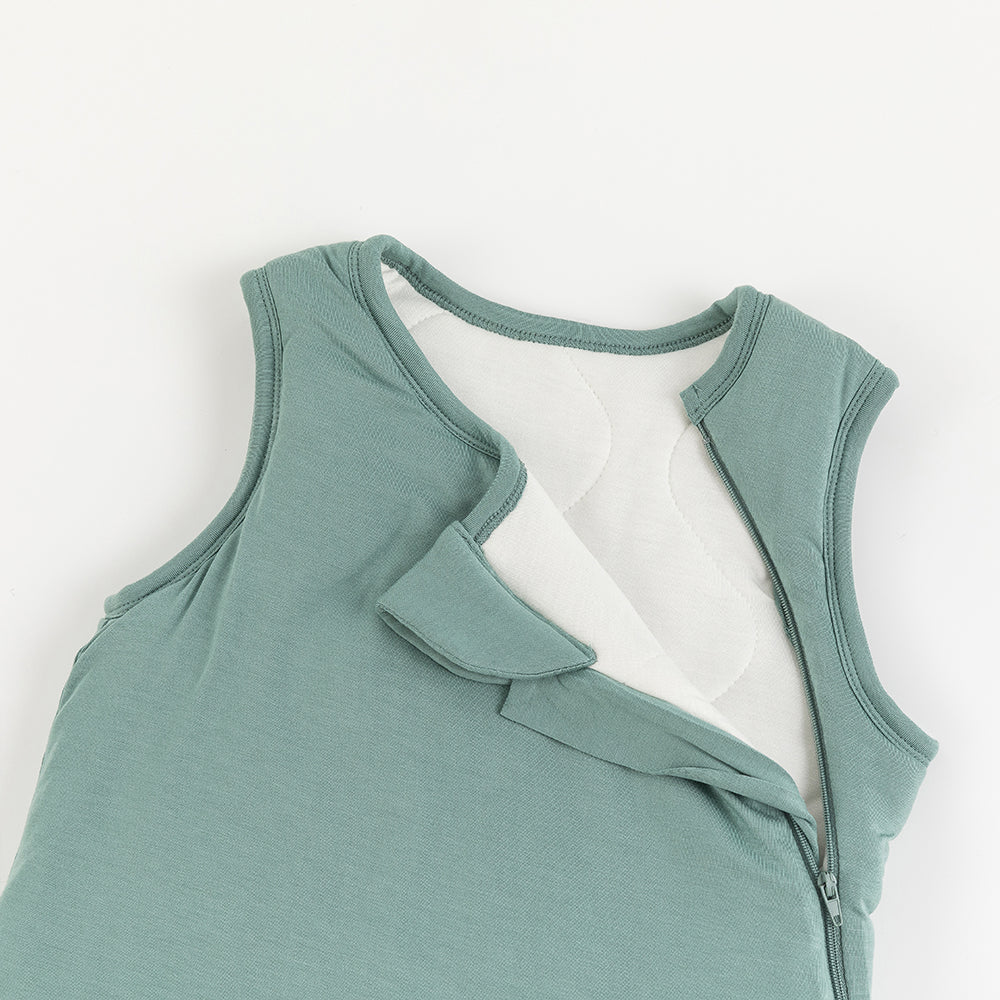
What is a baby sleeping bag?
Share
Designed for newborns to keep them safe, cozy, and cuddled during naps, a sleeping bag—also called a sleep sack—is a wearable blanket. Safer than a loose blanket, this one-piece, blanket-style onesie is Its sleeping bag base keeps baby warm and cosy from head to toe, holes or sleeves fit the arms, and its opening allows baby's head to move.
For what purposes do sleeping bags find application?
A sleeping bag is a wearable blanket designed to enable infants sleep more safely. Given the risk of sudden infant death syndrome (SIDS), the American Academy of Pediatrics and the Canadian Pediatric Society advise against blankets for newborns. To guarantee warmth and safety at bed, many parents thus decide to use sleeping bags for their children.
What is the difference between a sleeping bag and a swaddle?
A sleeping bag and a swaddle differ primarily in whether the baby's arms and legs may move freely during napping or sleep. The best decision relies on your baby's developmental level and age.
A baby sack is a wearable blanket fit for newborns and up. Its loose-fitting sack bottom design with armholes or cuffs facilitates simple movement even during the most active sleep. Little ones can find the most comfortable sleeping posture by freely moving their arms and legs—and even roll over in their sleep—thanks to sacks.
Newborns and babies find the same comfort, security, and warmth swaddling offers from the womb. Parents swaddle their infant in a swaddle blanket, much as a baby burrito is wrapped. Comfortable swaddling covers the infant's small arms and legs, which limits movement and prevents the baby from waking up due to the startle reflex.
From Swaddling to a Sack: How to Transition Your Baby
Your baby's development depends on you moving them from swaddling to a sack as they get more mobile.
The following detailed instructions walk you from swaddling to a sleep sack:
When your baby begins showing signs of rolling over or around two to four months old, many experts advise switching from swaddling to a sleep sack.
Change slowly: Steer clear of abrupt changes in sleep patterns. Starting one arm outside the swaddle, place the other arm inside. Let one arm move freely to help your infant become used to motion.
Pay close attention to your baby's development; swaddling is no longer safe if your baby can roll over onto their tummy since they might not be able to roll back over, so posing a safety concern. You should stop swaddling totally at this point.
Choose a baby sleep sack appropriate for the season based on size.
Create a nightly ritual whereby your baby will be signaled to be ready for sleep by following a set series of activities before bed.
Some newborns require some time to transition from the security of a swaddle to the freedom of a sleep sack.

Is a sleep sack required?
Babies will find great comfort sleeping in blankets. Though they are not essential, sleeping bags give parents peace of mind and security for their infants. Breathable and thermoregulating materials—like bamboo—sleeping bags can also give parents peace of mind knowing their children won't overheat or overcool while they sleep.
Under their sleeping bags, what ought babies to wear?
The season, the baby's room's temperature, and the TOG rating of the sleeping bag will all affect what babies wear beneath their blankets.
On cool evenings, generally speaking, babies should wear pajamas or rompers beneath their sleeping bags. Young infants can wear rompers or just diapers under their sleeping bags in warmer seasons.
When should newborns start donning sleeping bags?
Usually later in their development—about three months of age or later—babies begin using infant sleeping bags or blankets. The parents decide when the best moment to switch to a sleeping bag.
Every baby is different, thus their preferences might influence when they begin to use a sleeping bag. While some newborns prefer the security of the womb, others find their arms and legs swaddled uncomfortable.
When ought newborns to stop using a sleeping bag?
Babies should stop sleeping in a sleeping bag once they start to move more at night and grow more active. Babies should leave their sleeping bag when they stand, jump, and even try to climb out of the crib. A sleeping bag covers their legs and feet, which would readily trip a moving baby or toddler. Young infants can now graduate into our sleeping bags.
Are baby sleeping bags safe?
Babies need more movement and freedom in their arms and legs around three to four months. Better choices than swaddling or loose blankets are sleeping bags and sleepwear.
Sleeping bags are quite safe and can be adjusted to a more comfortable sleeping posture as long as the arms of babies are free to move. Babies' arms are free to move and sleeping bags give them the security they need to sleep.
Babies who can roll over should use sleeping bags; they are safer sleeping in a sleeping bag than in a swaddle. Should they roll over in a swaddle, they run the danger of becoming caught in a position from which they cannot escape, so increasing their SIDS risk. Sleeping in a sleeping bag lets their arms move free so they might push to roll over once more.
Do sleeping bags stop SIDS?
Although they themselves cannot stop SIDS, sleeping bags help to make sleep safe. Sleeping bags replace conventional loose blankets that, should they fall over a baby's face, might cause suffocation. One of the main elements in lowering the risk of SIDS is keeping babies warm while maintaining their airways open, which sleeping bags help accomplish.
Can newborns overheat in blankets?
If a baby is overdressed, wearing a TOG-rated sleeping bag that is too hot for their room, or if the room lacks enough air circulation, they may overheate in their sleeping bags.
By spotting symptoms of overheating—such as red cheeks, sweating, or the back of the neck feeling hot to the touch—parents can help their infants avoid overheating. Should you observe these indicators, change the baby's clothes or room temperature.
When to stop using a sleeping bag
Knowing when to stop using a sleeping bag is just as important as knowing when to start using one. Many parents are unsure when their baby should transition from a sleeping bag to a blanket. The American Academy of Pediatrics recommends starting to use a blanket after the baby is 12 months old, along with using other loose bedding and loose clothing, such as well-fitting sleepwear, which are considered safe at this stage.
There is no set age to stop using a sleeping bag, but most children will naturally outgrow a sleeping bag once they have a blanket on their bed. As your child becomes more mobile, they may feel that the sleeping bag is too tight and try to kick it off or unbutton it. This is a clear sign that they are ready to choose other sleepwear, such as pajamas or blankets.
However, some children may be comfortable in a sleeping bag for longer, and if they are comfortable and the sleeping bag still fits well, there is no need to rush to change. As long as they have enough room to kick their legs and move freely, they can safely continue to wear a sleeping bag.
When newborns sleep soundly, parents relax. Miozing creates sleepwear and blankets parents can rely on to keep their small children warm and safe. Every wearable blanket we create is created from premium, environmentally friendly materials, meticulously crafted, and completely thought out for utility.
